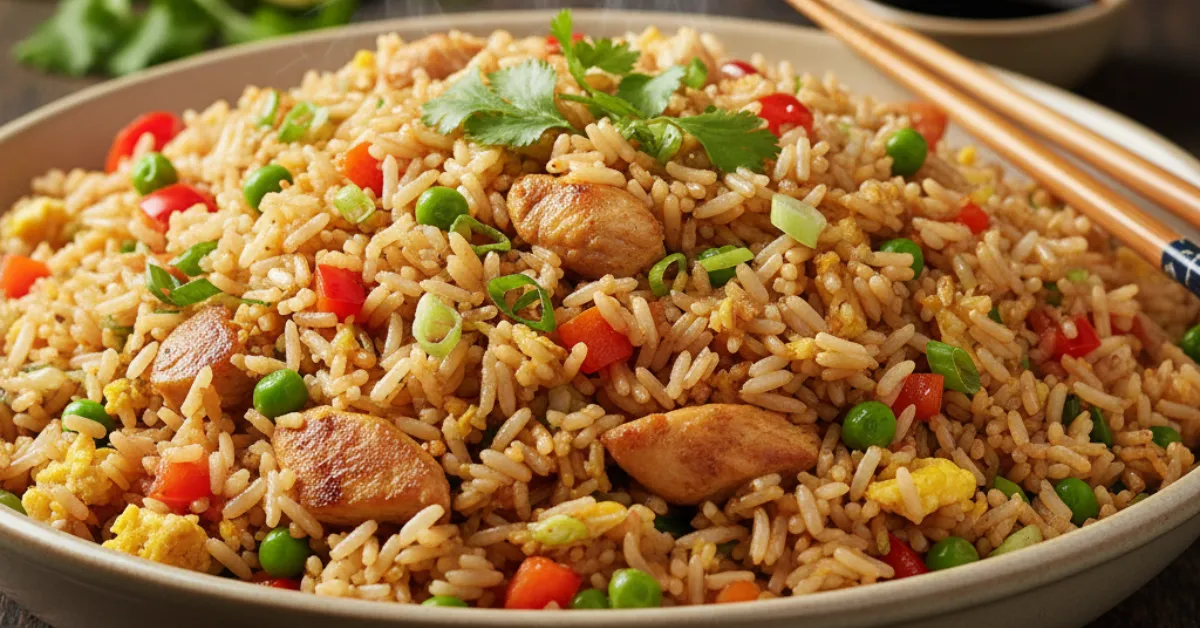The **fried rice recipe** is a global favorite for a reason. It is the ultimate fusion of simplicity, flavor, and incredible speed, making it the perfect choice for a last-minute **Dinner** or quick **Lunch**. Forget the heavy, greasy takeout version; mastering a truly great, authentic-tasting **homemade fried rice** is surprisingly easy, provided you follow one non-negotiable rule: you must use day-old, cold rice.
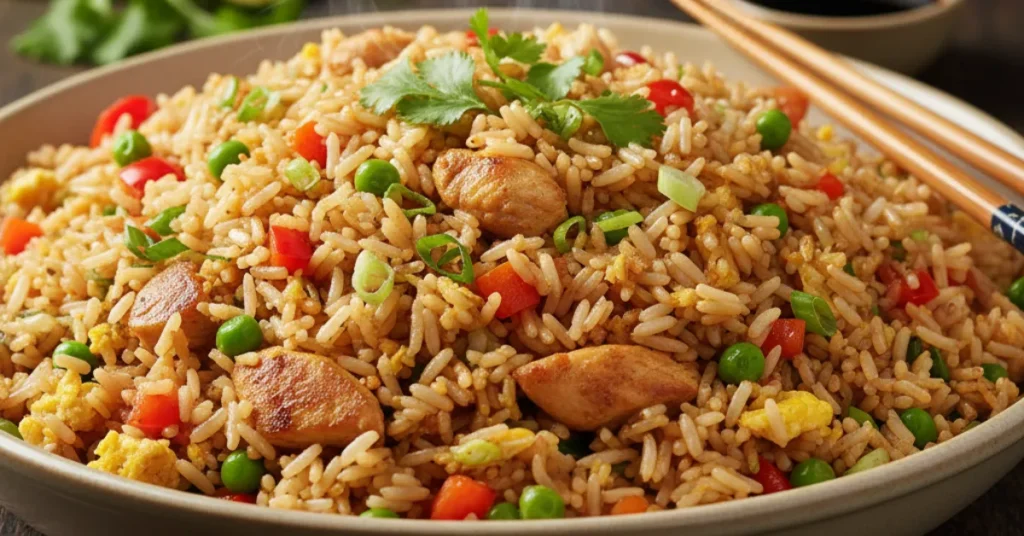
A successful **fried rice recipe** is about balance: the savory depth of soy sauce, the aromatic punch of ginger and garlic, and the satisfying texture of perfectly separated, toasted rice grains. The technique is fast, efficient, and relies on having all your ingredients pre-prepped—a concept known in Chinese cooking as *mise en place*. This is essential for preventing ingredients from burning at the high temperatures required.
We’ll show you how to master the basic vegetable version and provide simple, delicious steps for high-demand variations like the **chicken fried rice recipe** and **shrimp fried rice recipe** that will satisfy the whole family.
This recipe is a true champion of the **Quick Recipes** category, capable of going from prep to plate in under 20 minutes. It’s an excellent way to use up leftovers and minimize food waste, turning simple ingredients into a meal far greater than the sum of its parts. Let’s dive into the essential techniques that separate good fried rice from the best.
- The Secret to the Best Fried Rice Recipe: The Rice
- Master the Classic Chicken Fried Rice Recipe
- Popular Variations of the Fried Rice Recipe
- Essential Technique for Authentic Homemade Fried Rice
- Easy Fried Rice Recipe: Steps for Busy Weeknights
- Ingredient Deep Dive: Why Certain Flavors Work
- Tips for a Vegetable-Forward Fried Rice Recipe
- Common Mistakes to Avoid When Making Fried Rice
- FAQ: Your Top Questions About Fried Rice Recipe
- Conclusion: The Ultimate Quick and Versatile Fried Rice Recipe
- Recipe Summary: Quick Fried Rice Recipe
- Steps to Follow (How to Make Fried Rice Recipe)
- Tools You’ll Need
The Secret to the Best Fried Rice Recipe: The Rice
If your **homemade fried rice** always turns out mushy or sticky, the problem isn’t your cooking—it’s your rice preparation. The secret to achieving the authentic, restaurant-quality **fried rice recipe** texture is the rice itself.
Why Day-Old Rice is Non-Negotiable for Homemade Fried Rice
Freshly cooked rice is high in moisture and starch. When you try to fry it, the grains steam, clump together, and absorb too much oil, resulting in a soggy, heavy dish. Day-old rice, however, has dried out and firmed up, allowing the grains to separate beautifully when hitting the hot wok or skillet.
The goal is to toast, or “fry,” the rice, not steam it. This simple shift in mindset makes all the difference in achieving that signature dry, fluffy texture.
- **Use Long Grain Rice:** Jasmine rice is the standard for the best **fried rice recipe**. Its grains hold their shape and stay separate when cooked.
- **Cook and Chill:** Cook your rice as usual, but use slightly less water than normal to encourage dryness. Once done, immediately spread it in a thin, even layer on a baking sheet. Place it in the refrigerator, uncovered, for at least 4 hours, but ideally overnight. This process is crucial for removing excess moisture.
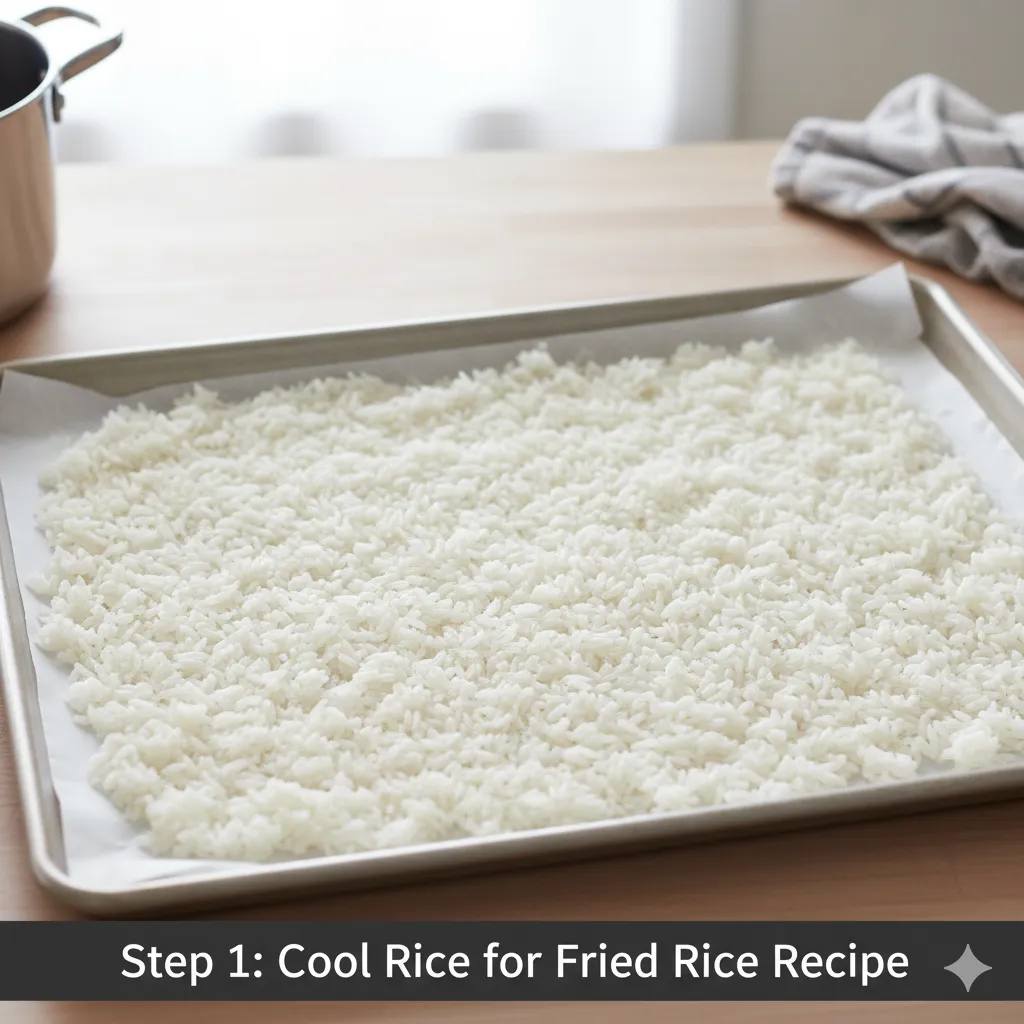
The proper moisture level also contributes to better flavor absorption. The dry, firm grains soak up the aromatic soy sauce and spices during the quick fry, resulting in a more flavorful **homemade fried rice** than you could ever achieve with fresh rice. For a deep dive into cooking rice specifically for frying, check out this guide on the science of preparing rice for fried rice.
Master the Classic Chicken Fried Rice Recipe
The **chicken fried rice recipe** is the most popular variation. It’s hearty, protein-packed, and quick to make. The key is preparing the chicken quickly and efficiently to ensure it stays tender and fully cooked before you add the rice.
Steps for a Perfect Chicken Fried Rice Recipe:
- **Marinate the Chicken:** Cut boneless, skinless chicken breast or thighs into $\frac{1}{2}$-inch pieces. Toss them with a tiny bit of soy sauce, cornstarch, and white pepper. The cornstarch forms a light protective layer that keeps the chicken moist.
- **Cook the Protein First:** Heat your wok or skillet with high heat (more on this essential technique later). Add a tablespoon of neutral oil. Stir-fry the chicken until it is cooked through and lightly browned (about 3–4 minutes). Remove the chicken from the wok and set it aside.
- **Aromatics and Vegetables:** Add more oil, then quickly sauté aromatics (garlic, ginger) and firm vegetables (diced carrots, peas).
- **Combine and Sauce:** Once the rice and chicken are reintroduced, pour the sauce mixture over everything and toss rapidly.
This technique ensures your **chicken fried rice recipe** avoids the dreaded overcooked, rubbery chicken and keeps the entire dish moving quickly, which is essential for a great quick meal. This method works perfectly for a satisfying **Dinner** or a large batch meal prep.
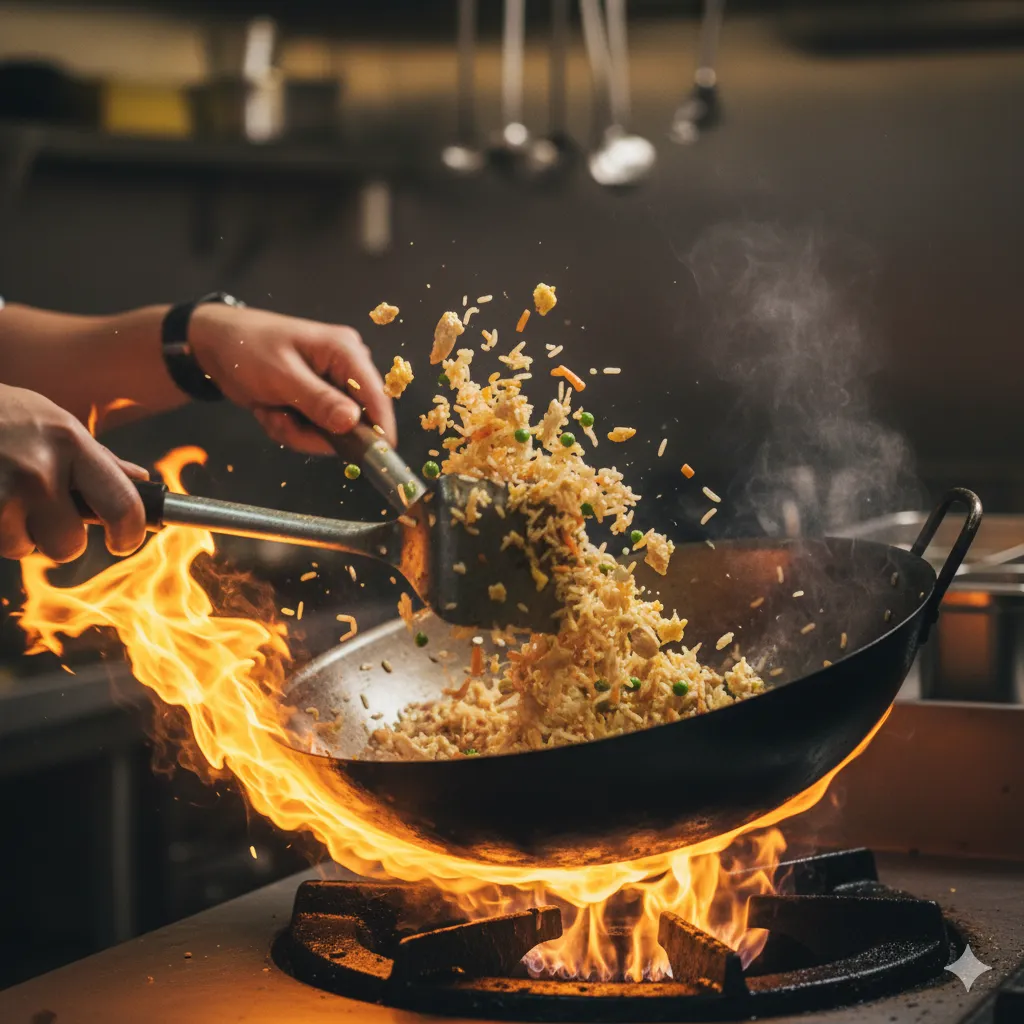
Popular Variations of the Fried Rice Recipe
Once you’ve mastered the basic technique, adapting it for other proteins is straightforward. The **pork fried rice recipe** and the **shrimp fried rice recipe** simply require minor adjustments to cooking time and preparation. These are great ways to keep this **Quick Recipe** fresh.
Pork Fried Rice Recipe:
Pork adds a wonderful richness to the dish, especially when using a slightly fattier cut like pork shoulder or belly, though tenderloin works great for speed.
- **Meat Choice:** Use diced pork tenderloin or pre-cooked char siu pork. If using pork belly, render the fat first before adding the aromatics, and reserve a tablespoon of the rendered fat for the final stir-fry for added flavor.
- **Cooking Time:** Pork requires a slightly longer cook time than chicken. Ensure the diced pork is fully cooked and slightly crispy before removing it from the wok.
Shrimp Fried Rice Recipe:
The **shrimp fried rice recipe** is the fastest protein variation. Shrimp cooks extremely fast, so timing is key to keeping it tender.
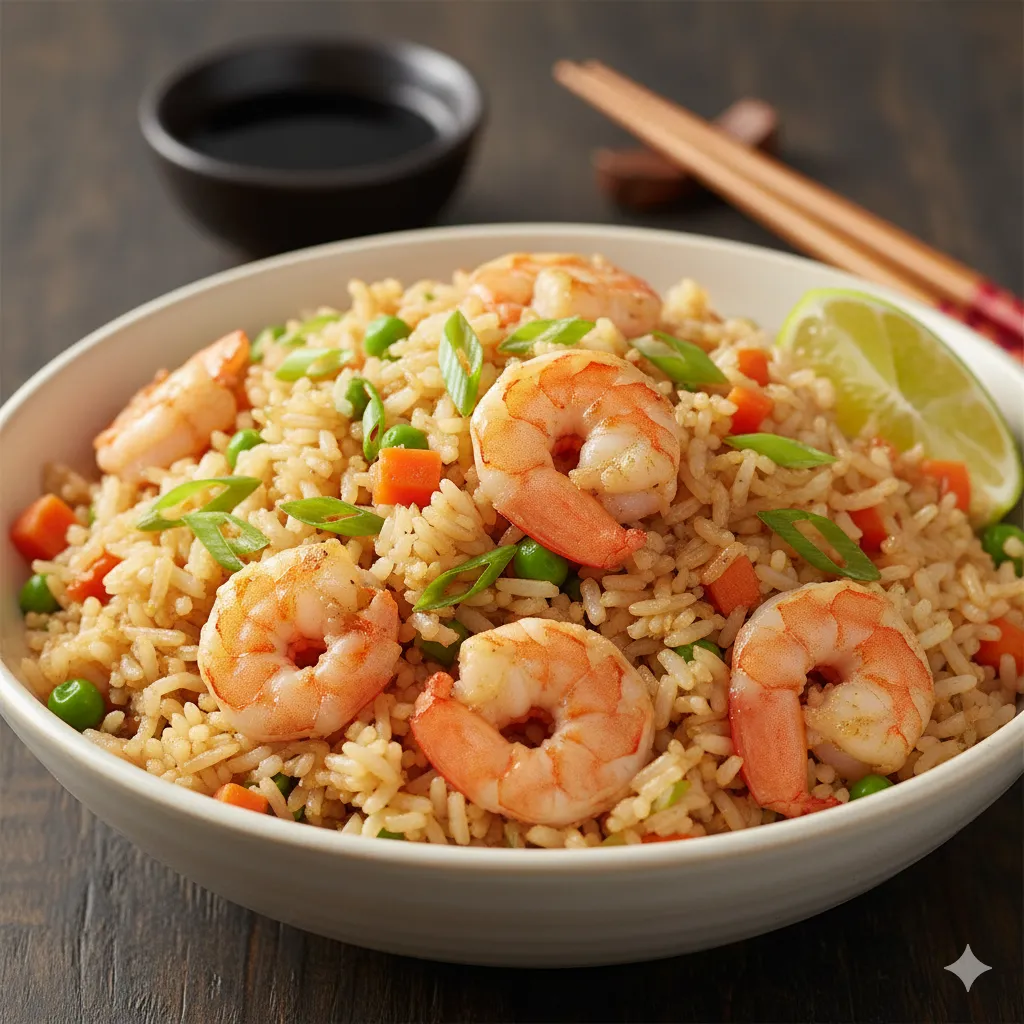
- **Pre-Cook the Shrimp:** Peel and devein your shrimp. Stir-fry them alone in the hot wok for just 1–2 minutes per side until they turn pink and opaque. **Crucially, remove them from the wok** before adding the vegetables and rice. Shrimp cooks so fast that leaving it in will result in a tough, rubbery texture.
- **Re-introduce at the End:** Add the shrimp back into the wok right as you toss in the sauce and scallions to simply warm them through. This guarantees tender, juicy shrimp in your **shrimp fried rice recipe**.
Essential Technique for Authentic Homemade Fried Rice
Beyond the quality of your rice, the technique you use—often referred to as ‘wok hei’ (the breath of the wok)—is critical. This smoky, slightly charred flavor is what makes Chinese-style **fried rice recipe** so irresistible. Even if you don’t own a traditional wok, you can still achieve excellent results by making a few adjustments.
High Heat is Your Friend
The entire process must be fast, furious, and hot. This allows the ingredients to quickly caramelize without releasing too much moisture. Use the highest heat your stove can safely handle.
- **Wok:** A carbon steel wok is ideal. Its thin construction heats up rapidly and evenly, and its shape allows for efficient tossing and movement, ensuring every grain of your **homemade fried rice** gets properly toasted.
- **Skillet Substitute:** If using a skillet, choose a large, heavy-bottomed cast iron or stainless steel pan. To maintain high heat, cook the dish in smaller batches. Overcrowding a skillet is the fastest way to steam your ingredients, leading to a disappointing **fried rice recipe** result.
Choosing the Right Oil for High-Heat Frying
Because you’re cooking at high temperatures, selecting an oil with a high smoke point is essential to prevent burning and bitterness. For an authentic and safe experience when making your **fried rice recipe**, use neutral oils such as:
- **Peanut Oil:** Traditional in Chinese cooking, it has a high smoke point and adds a subtle, pleasant nutty fragrance.
- **Canola Oil or Vegetable Oil:** These are affordable, neutral options with reliably high smoke points.
- **Refined Avocado Oil:** An excellent choice with one of the highest smoke points available.
Avoid Extra Virgin Olive Oil, as its low smoke point will cause it to burn and smoke rapidly under the required heat. For more information on safely cooking with high heat, this guide on selecting the best high-smoke-point oils for stir-frying offers further detail.
Easy Fried Rice Recipe: Steps for Busy Weeknights
Sometimes you need an absolutely foolproof, minimal-ingredient dish. This **easy fried rice recipe** focuses only on the essentials to get a savory, satisfying meal on the table in minutes. This is a classic **Quick Recipes** solution.
Simplified 15-Minute Recipe:
- **Protein:** Use pre-cooked, diced ham, bacon, or leftover diced rotisserie chicken. Skip the pre-cooking step entirely for a streamlined process.
- **Vegetables:** Use frozen mixed peas and carrots. Do not thaw them; add them directly to the hot wok to cook quickly.
- **Sauce:** Pre-mix your sauce (soy sauce, a dash of sugar, and a few drops of sesame oil) in a small bowl.
- **The Fry:** Scramble eggs, remove. Add oil, then immediately add the frozen vegetables. Stir-fry for 1 minute. Add the cold rice and the pre-cooked protein. Stir-fry vigorously until the rice is hot and toasted (about 2–3 minutes).
- **Finish:** Add the scrambled eggs and the pre-mixed sauce. Toss for 30 seconds until the sauce coats everything evenly. Serve immediately.
Using these shortcuts, you can still enjoy a fantastic **fried rice recipe** even on your busiest days. It’s the ultimate in utilizing leftovers for a hearty, flavorful dish. For those evenings when you need another simple, yet impressive **Dinner** side, try our guide to the Roasted Potatoes , which uses a technique similar to the fried rice for achieving a super crisp exterior.
Ingredient Deep Dive: Why Certain Flavors Work
The flavor profile of any great **fried rice recipe** hinges on the interaction between a few powerful ingredients. Understanding their role is key to customizing your dish perfectly.
Aromatics and Finishers
- **Soy Sauce:** Provides essential saltiness and umami depth. Use light (not low-sodium) soy sauce for seasoning and a dash of dark soy sauce for color, if desired.
- **Oyster Sauce (Optional):** Adds complex savory flavor and a hint of sweetness. It provides incredible ‘oomph’ to any **homemade fried rice** but can be omitted for vegetarian or vegan diets.
- **Toasted Sesame Oil:** This is a finishing oil. Its smoke point is too low for frying, but a few drops added right at the very end provides the iconic, nutty aroma that defines classic Chinese **fried rice recipe**.
- **White Pepper:** Traditional and irreplaceable. It offers a subtle, sharp heat that differs from black pepper and complements the savory notes perfectly.
The versatility of this dish extends beyond dinner and lunch. It’s also an excellent party appetizer or component of a larger spread. Speaking of appetizers, if you are planning a gathering, our famously creamy Spinach Dip Recipe is another popular choice in our **Quick Recipes** category that is easy to prepare ahead of time.
Tips for a Vegetable-Forward Fried Rice Recipe
While protein variations like **chicken fried rice recipe** and **shrimp fried rice recipe** are popular, a great vegetable **fried rice recipe** can be equally satisfying. The trick is timing the addition of vegetables based on their cooking needs.
Cooking Vegetables for the Best Fried Rice
- **Hard Vegetables First:** Carrots, corn, and snap peas should be added first, as they need the most time to soften and slightly caramelize.
- **Leafy Greens Last:** Spinach, bok choy, or cabbage should be added right before the rice, as they wilt almost instantly.
- **Tofu Option:** For a vegetarian **homemade fried rice**, use extra-firm tofu that has been pressed and diced. Cook the tofu until crispy before removing it and following the standard recipe steps.
A well-executed vegetable version is a healthy, customizable meal that adheres perfectly to the core principles of a successful **homemade fried rice**—high heat, cold rice, and fast cooking. Remember that the ultimate **easy fried rice recipe** is one that utilizes whatever vegetables you have on hand.
Common Mistakes to Avoid When Making Fried Rice
Even with the best ingredients, small errors can ruin the final texture and flavor. Here are the most critical mistakes to avoid to ensure your **fried rice recipe** is always a success:
- **Do Not Use Freshly Cooked Rice:** As stressed above, this is the number one cause of mushy fried rice. Use rice that is completely cold and dry.
- **Do Not Overcrowd the Wok:** If the pan is too full, the temperature drops, and the ingredients steam instead of fry. If you are making a large batch, cook it in two smaller batches.
- **Pre-Chop Everything:** The cooking process is incredibly fast. You will not have time to chop garlic or slice scallions while the wok is hot. Have all ingredients—protein, vegetables, and sauce—ready and within arm’s reach before you turn on the heat.
- **Avoid Low Heat:** Low heat equals steaming. You need high heat to achieve the rapid caramelization and crisping of the rice and the ‘wok hei’ flavor.
By avoiding these common pitfalls, your journey to making the **best fried rice recipe** will be smooth and delicious. The dedication to high heat is what makes this a great **Dinner** option, as the cooking time is minimized.
FAQ: Your Top Questions About Fried Rice Recipe
Why is my fried rice sticky and mushy (how to make fried rice recipe better)?
The primary reason your **fried rice recipe** is sticky is using freshly cooked rice. Fresh rice is too moist and high in starch. You must use rice that has been cooked, spread thinly on a tray, and chilled in the refrigerator for at least 4 hours or, ideally, overnight. This process dries out the exterior of the grains, preventing them from clumping in the wok.
What is the best type of rice to use for a fried rice recipe?
Jasmine rice is hands-down the best choice for an authentic **fried rice recipe**. Its long grain and texture are perfect for achieving separate, fluffy grains after cooling. Basmati or long-grain white rice are also acceptable substitutes, but avoid short-grain or sticky rice varieties.
Can I skip the egg in the homemade fried rice?
Yes, you can. The scrambled egg provides protein and texture, but it is not essential to the overall structure of the **homemade fried rice**. For a simple, minimalist version, you can certainly omit the eggs or replace them with crumbled firm tofu for a vegetarian option.
How do I get the ‘wok hei’ smoky flavor in my fried rice recipe?
To achieve the ‘wok hei’ or smoky flavor, you must cook your **fried rice recipe** in small batches and use extremely high heat. The small amount of oil and food that hits the smoking hot metal of the wok or skillet will instantly caramelize and create that signature charred, smoky flavor. Do not overcrowd the pan!
How long does leftover fried rice last?
Properly stored, leftover **fried rice recipe** should be consumed within 3 to 4 days. It must be cooled and refrigerated quickly after cooking, ideally within one hour, to prevent the growth of bacteria associated with cooked rice.
Can I use brown rice for this recipe?
While white rice is traditional, you can use brown rice, but the cooking time in the wok will be slightly longer. Since brown rice is chewier and has a harder exterior, ensure it is completely cold and use an extra tablespoon of oil to help the grains crisp up without drying out too much. The principles of high heat and cold rice still apply.
What is the recipe for fried rice (basic version)?
The basic **recipe for fried rice** involves stir-frying pre-cooked protein and firm vegetables, scrambling eggs and removing them, then stir-frying day-old rice until toasted. Everything is then combined and quickly tossed with a simple sauce made of soy sauce, a touch of sugar, and sesame oil. This method is the foundation for all variations, including **how to make chicken fried rice recipe**.
How to make vegetable fried rice recipe?
To **make vegetable fried rice recipe**, follow the basic steps but increase the amount of vegetables, using a mix of hard (carrots, bell peppers) and soft (cabbage, spinach) vegetables, adding the harder ones first. Skip the protein and add the eggs back in with the rice.
How to cook chicken fried rice recipe?
To **cook chicken fried rice recipe**, dice chicken breast or thigh, marinate it briefly with cornstarch and soy sauce, and cook it fully in the wok first. Remove it, proceed with the aromatics and rice, then add the chicken back in during the final toss to warm it through and coat it in the sauce.
Conclusion: The Ultimate Quick and Versatile Fried Rice Recipe
The **fried rice recipe** stands as a testament to the power of simple ingredients combined with proper technique. By focusing on the core principles—cold rice, high heat, and efficient prep—you can easily elevate this humble staple into a dish that rivals your favorite takeout.
Whether you choose the robust **pork fried rice recipe**, the classic **chicken fried rice recipe**, or the snappy **shrimp fried rice recipe**, the results will be a satisfying, flavorful meal that works for any time of day.
Embrace this **easy fried rice recipe** as your go-to solution for busy weeknights and a fantastic way to utilize leftovers. It’s a versatile, economical, and delicious addition to your **Dinner** rotation, proving that the best food is often the fastest to make.
Recipe Summary: Quick Fried Rice Recipe
→ Dry & Produce Ingredients
- 3 cups cold, day-old cooked Jasmine rice
- 1 cup diced protein (chicken, shrimp, or pork)
- ½ cup frozen peas and carrots blend
- 2 large eggs, lightly beaten
- 2 cloves garlic, minced
- 1 inch ginger, grated (optional)
- 3 scallions, chopped (whites and greens separated)
→ Sauce & Oil
- 3 tablespoons neutral, high-smoke-point oil (peanut or canola)
- 3 tablespoons soy sauce (or to taste)
- 1 tablespoon oyster sauce (optional)
- ½ teaspoon white sugar
- ½ teaspoon toasted sesame oil (for finishing)
- White pepper to taste
Steps to Follow (How to Make Fried Rice Recipe)
- Heat 1 tablespoon oil in a wok or large skillet over high heat. Cook the protein (chicken, shrimp, or pork) until fully cooked. Remove and set aside.
- Add remaining oil. Scramble the eggs briefly, remove and set aside.
- Add garlic, ginger (if using), and scallion whites to the hot wok. Stir-fry for 30 seconds.
- Add frozen vegetables. Stir-fry for 1 minute.
- Add the cold rice and stir-fry vigorously, breaking up any clumps, until the rice is heated through and slightly toasted (about 2-3 minutes).
- Pour the soy sauce, oyster sauce (if using), and sugar over the rice. Toss rapidly to coat.
- Return the cooked protein and scrambled eggs to the wok. Toss briefly.
- Stir in the sesame oil and scallion greens. Serve immediately.
Tools You’ll Need
- Wok or large, heavy-bottomed skillet
- Metal spatula for tossing
- Small bowl for sauce mixing
- Baking sheet for cooling rice (optional but recommended)

